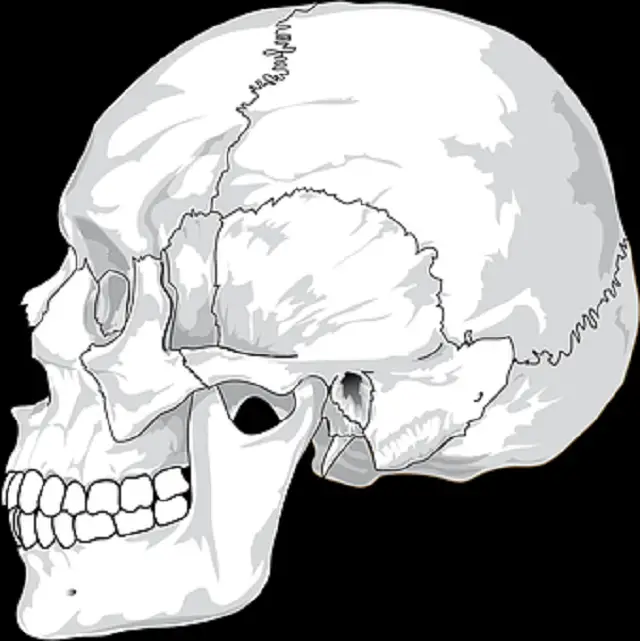If you know the basics of human anatomy you would appreciate the uniqueness of the skull. Our skull is not only an intriguing structure but also serves very important functions. The most well-known duty of a skull is to protect our brain. However, the skull has more responsibilities than just that.
What Makes Human Skull so interesting?
There are twenty-two bones that intricately join together to form a skull. The interesting thing about the human skull is that it’s not entirely made up of bones. Your skull has ligaments that help with the movement, including the movement of the mouth. Skull also has cartilage and if you want to get familiar with what cartilage is, try wiggling the tip of your nose with a finger. There, you just met with your very own cartilage.
Let’s dig deeper into more fun facts about our skull.
Braincase vs. Skullcap
A lot of people confuse the two and perceive them as the same thing. Braincase includes bones that offer protection for your brain (from neurocranium) and enclose it like a ‘case’. There are six different types of bones in our braincase, including sphenoid, ethmoid, occipital (two), frontal, temporal (two), and parietal bones. If you don’t count ethmoid and sphenoid bones, then you have the skullcap, also known as calvaria. So, calvaria happens to be a subcategory of the neurocranium.
What is Included in the Facial Skeleton?
The facial skeleton has many bones that would rouse your curiosity. For example, when you start reading all about Vomer bone, you would find it quite unique in its function. The vomer is a curious little thing that supports the nasal passage and divides it into two portions.
The facial skeleton has 14 bones, including mandible (the jaw), vomer (shaping your nose), several paired bones (maxillae, nasals, lacrimals, palatines, zygomatic and nasal conchae inferior). Our face also has nasal cartilages that are connective tissues giving shape to your nose. The upper teeth are attached to the maxillae and the lower ones are attached to the mandible, but the teeth are not part of the facial skeleton. This is interesting because it happens to be a commonly circulating myth that teeth are bones; they are not.
Your Skull has holes in it!
Don’t freak out just yet. These tiny holes, also called foramina, are apertures that are present in the human skull naturally. Their primary function of foramina is to serve as a passage for vessels and nerves. The largest foramen, also known as ‘foramen magnum’ is located in the occipital bone and base of the skull. It provides passage for the spinal cord and vertebral arteries.
The Temporomandibular Joint Game
In case you are ever bored, you can just touch the area just in front of your ears, then open your mouth and close it. The movement that you feel is of your mandible and it’s quite fascinating to feel it like that. The temporomandibular joint consists of the mandible, temporal bone, and ligaments that provide strength for the area during cranium-mandible articulation. The joint serving as a primary hinge in this area is called the sphenomandibular ligament.
The Skull Bones that Are Hidden From You
Let’s be honest, you never even imagined that there would be such a bone in your skull, right? Foramina ethmoid (full) and Palatines (L-shaped) are the hidden bones that you won’t feel just by touching your face or head.
The ethmoid bone happens to be located at the roof of your nose and also between your eyes; you will find small apertures (foramina) over here. Nerve cells that are located in your nose, are responsible to detect different odors and then pass these signals through the ethmoid foramina to the olfactory bulb and later on to the brain via the olfactory tracts (pretty straightforward ride, huh?). Thankfully, because of this meticulous organization, you get to distinguish between a scrumptious Big Mac from a mouldy bowl of rice, just by their odors.
Are You Still Confused About the Structure of Skull?
If you are still confused and don’t understand all the bony-names we enlisted above, don’t panic. A helpful way is to explore a 3D skull diagram and play around guessing names of different bones. It would help you clarify your concepts and also try to feel the same bones on your face. The tactile and interactive visual input should do wonders to enhance your understanding of the structure of our skull.
As interesting as it sounds, the human anatomy is a tad bit overwhelming. Add some bones to the anatomy and you are with the perfect recipe for a hard to comprehend but very interesting topic in human anatomy. If our skull is this complicated, imagine the complexity of the entire human skeleton. It is remarkable to see how nature has been at work, improvising and evolving the skeletal anatomy of homo-sapiens to the point of perfection to date.





